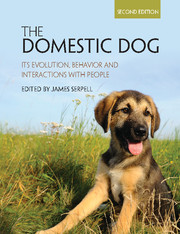Book contents
- Frontmatter
- Dedication
- Contents
- List of contributors
- 1 Introduction
- PART I ORIGINS AND EVOLUTION
- PART II BEHAVIOR, COGNITION AND TRAINING
- 5 Genetics of dog behavior
- 6 Becoming a dog: Early experience and the development of behavior
- 7 Breed and gender differences in dog behavior
- 8 Dog social behavior and communication
- 9 Ethology, ecology and epidemiology of canine aggression
- 10 Social cognition and emotions underlying dog behavior
- 11 The learning dog: A discussion of training methods
- 12 Dogs in today's society: The role of applied animal behavior
- PART III DOG-HUMAN INTERACTIONS
- PART IV LIFE ON THE MARGINS
- Index
- Plate section
- References
9 - Ethology, ecology and epidemiology of canine aggression
from PART II - BEHAVIOR, COGNITION AND TRAINING
Published online by Cambridge University Press: 30 December 2016
- Frontmatter
- Dedication
- Contents
- List of contributors
- 1 Introduction
- PART I ORIGINS AND EVOLUTION
- PART II BEHAVIOR, COGNITION AND TRAINING
- 5 Genetics of dog behavior
- 6 Becoming a dog: Early experience and the development of behavior
- 7 Breed and gender differences in dog behavior
- 8 Dog social behavior and communication
- 9 Ethology, ecology and epidemiology of canine aggression
- 10 Social cognition and emotions underlying dog behavior
- 11 The learning dog: A discussion of training methods
- 12 Dogs in today's society: The role of applied animal behavior
- PART III DOG-HUMAN INTERACTIONS
- PART IV LIFE ON THE MARGINS
- Index
- Plate section
- References
Summary
Introduction
In Man Meets Dog (1953), Konrad Lorenz praised the wonders of domestication that, in a few thousand years, had transformed the wolf into the docile Alsatian dog that his children could playfully and fearlessly torment. Lorenz admitted in his later years that much of what he had written about dogs was simply incorrect. His assumption that domestication had largely purged the wolf of the behavior that made it potentially dangerous to man was one of his more serious errors.
For many years the phrase “dog bites man” was a cliché for an event that is the antithesis of news, largely because it is such a common occurrence. In the last two decades, however, media around the world have given enormous attention to dog attacks and dog aggression in general. This has created the popular impression that such attacks have become more numerous or severe. Much of this attention has focused on specific breeds assumed to have a greater propensity for aggression, and the various legal and legislative attempts to protect the public from “vicious dogs.” In addition, increased law enforcement attention to dogfighting and several high-profile prosecutions, including that of National Football League quarterback, Michael Vick, have led to widespread discussion of the breeding, raising, training and potential rehabilitation of dogs used in organized dogfighting (Gorant, 2010; Huss, 2008; Lockwood, 2011) and have renewed the debate over the genetic, environmental and sociological contributions to canine aggression.
The issue of aggression problems in dogs has also attracted growing attention as a welfare concern. Salman et al. (1998, 2000) surveyed 12 animal shelters in the US and noted that 40% of relinquishing owners cited behavioral problems as one of the reasons for surrendering a dog. When behavior was the only reported reason for relinquishment, aggression was the most frequently cited problem (40% of dogs). In addition, surveys of owner's complaints about canine behavior indicate that the most common problem reported is aggression (Beaver, 1993, 1994) and such problems produce a significant risk for euthanasia (Fatjo et al., 2007; Galac & Knol, 1997; Hart & Hart, 1997; Reisner et al, 1994). Thus identifying animals at risk for such problems, and identifying potentially effective solutions, has been a major effort for animal behaviorists working within rescue and shelter settings.
- Type
- Chapter
- Information
- The Domestic DogIts Evolution, Behavior and Interactions with People, pp. 160 - 181Publisher: Cambridge University PressPrint publication year: 2016
References
- 2
- Cited by



